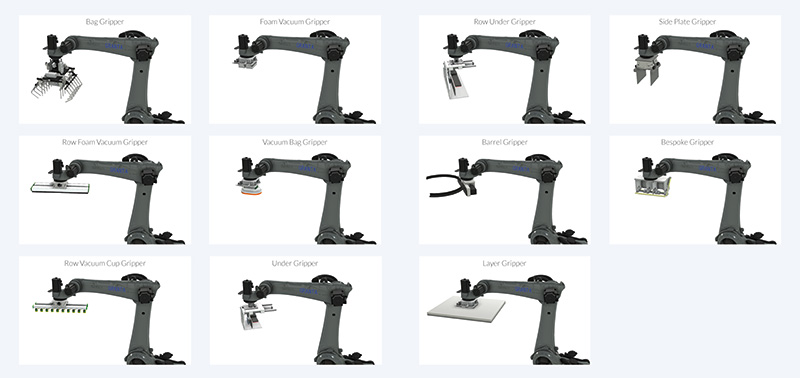At the heart of every robotic palletiser lies the gripper—an essential component responsible for securely interacting with the products being moved. Choosing the right gripper type can make all the difference in ensuring operational efficiency, product safety, and overall productivity. Here we will look into the various gripper types available for robotic palletisers and their unique features, applications, and key considerations for selection.

1. Foam Vacuum Gripper
Foam vacuum grippers are an excellent choice for handling products with flat top surfaces. These grippers use suction to lift items securely from the top, making them a popular option for boxes, display boxes, cartons, and certain types of packed products or bags.
Foam vacuum grippers can be designed to either pick and place single or multiple items at a time depending on the speeds required.
Beyond product handling, foam vacuum grippers can also be used for managing additional tasks such as moving empty pallets and placing slip sheets between product layers.
2. Bag Gripper
Tailored specifically for bags and sacks of varying sizes, bag grippers offer a robust design equipped with positioning pins, lifting pins, and a centre clamp. This combination ensures the bag remains stable and supported during movement, reducing the risk of slippage or misalignment during palletisation. The two sets of pins clamp around the bag and the centre clamp clamps onto the bag, keeping the bag securely in the gripper whilst it is moved. As the gripper places the bag onto the pallet, the lifting pins are released whilst the positioning pins remain in place to guide the bag into the correct position on the pallet. Depending on the product in the bag, the centre clamp may also be used to push the bag and distribute its contents more evenly to create a better pallet stack.
These grippers typically work in conjunction with a specialised sack pick conveyor, which evenly distributes the bags contents and positions the bag for optimal handling. This level of precision allows for neatly stacked pallets, even for bulky or irregularly shaped sacks. This gripper type is best suited to bagged products such as powdered materials, granular products, or other bagged goods.
3. Underneath Gripper
When vacuum gripping isn’t an option—such as with open-top plastic or cardboard crates, open-top boxes, or shrink-wrapped products like packs of bottles—underneath grippers are the best option. These versatile tools operate by sliding the product off the conveyor onto a flat plate, then clamping it securely in place as it is being lifted.
Once the product is positioned on the pallet, the top clamp releases, and the plate retracts, ensuring a smooth and efficient process. Many underneath grippers also incorporate vacuum components, enabling them to handle tasks like moving empty pallets or slip sheets.
Underneath grippers can pick and place single or multiple items at a time, depending on the production speeds required.
4. Parallel/Side Plate Gripper
Parallel grippers are designed for regular-shaped products such as boxes or shrink-wrapped trays that are unsuitable for vacuum gripping. These grippers use two side plates that close in parallel onto the sides of the product, providing a firm yet gentle grip for lifting. Once the item is securely placed on the pallet, the gripper releases, ready for the next product.
5. Bespoke Gripper
A bespoke gripper is the go-to solution when none of the standard grippers can effectively handle a product. These custom-designed grippers are tailored for specific needs, making them ideal for irregularly shaped, large, or heavy items such as drums, cans, bottles, or uniquely configured products.
Bespoke grippers are also often engineered to handle ancillary tasks such as picking and placing empty pallets or managing slip sheets.
Key Considerations for Selecting the Right Gripper
Eachgripper type serves a unique purpose, catering to specific product shapes, sizes, packaging requirements and production speeds. By selecting the right gripper for your needs, you can optimise productivity, reduce downtime, and ensure the safe handling of your products. Factors to consider include:
- Product Shape and Size: Regular versus irregular shapes.
- Weight and Load: The gripper must support the product’s weight without compromising stability.
- Surface Characteristics: Smooth, rough, or fragile surfaces may dictate the type of gripper used.
- Packaging Type: Bagged, boxed, or shrink-wrapped products require different gripping mechanisms.
Consulting with automation experts and conducting trials with your specific products are vital steps to ensure the chosen gripper meets your requirements.
Robotic palletising isn’t just about automation—it’s about innovation, precision, and adaptability. With the right gripper, you can achieve all three and elevate your material handling processes to new heights.
If you would like to know more about the Granta palletising systems or AMR/AGV systems, then please do get in touch on 01223 499488 or contact us at helpline@granta-automation.co.uk. We will be very happy to help.
Find out more…
- Ways To Speed Up The Palletising Process In Production
- How To Automate Cross Palletising and Depalletising from UK to Euro Pallets
- How Cycle Time Reduction Improves Operational Efficiency
- Autonomous Mobile Robot (AMR) Pallet Stations, Charging Stations, and Conveyor Stations
- Mastering Budget Planning: Advanced Methods for Planning and Allocating Capital Budgets in Manufacturing







